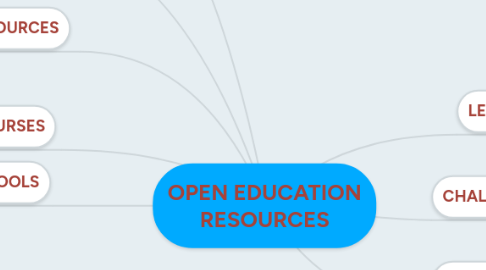
1. COURSES
1.1. UNESCO
1.2. Curriki
1.3. OpenStax College
1.4. Academic Earth
1.5. WebCast Berkeley
2. TOOLS
2.1. Social softward
2.1.1. Wikis
2.1.2. OSLO research
2.1.3. H2O
2.2. Development tools
2.2.1. Connexions
2.3. Learning managment systems
2.3.1. Moodle
3. IMPLEMENTATION RESCOURCES
3.1. Licensing tools
3.1.1. Creative commons
3.1.2. GNU Free documentation licnse
3.2. Best practicis
3.2.1. CMU (design principles)
3.3. Interoperability
3.3.1. IMS
3.3.2. SCORM
4. CHARACTERISTIC OF OPEN EDUCATION RESOURCES
4.1. Freely accesible content resources
4.2. Freely reusable copyrights and formats
4.3. Design is considerate of bandwidth and accessibility
4.4. Freedom and openness as principles in their production and use
5. BENEFITS FOR:
5.1. TEACHER
5.1.1. New opportunities for staff development
5.1.2. Improve public engagement
5.1.3. improved public engagement
5.1.4. widening access and participations.
5.1.5. Marketing and reputation building throught showcasing the work of the institution.
5.2. COMMUNITIES
5.2.1. Enables new kind of coloboration
5.2.2. Provides opportunities for profile raising
5.2.3. Strengthens relationships between educational establishments and other organisations (such as goverment organisations, charitable trusts, business and employers).
5.2.4. Facilitates subject-based collaboration.
5.2.5. Enables cross-disciplinary collaboration.
5.3. LEARNER
5.3.1. A clearer idea of what it's like to study within a particular institution, subjct area or course prior to application.
5.3.2. Access to supplementary resources to support study skills.
5.3.3. Free access to educational resources without being required to enrol in an institution.
5.3.4. A curriculum which is integrated into real life experience.
5.3.5. Free-of-charge access to a wide range of educational resources worlwide.
5.4. INSTITUTION
5.4.1. Extending the institutions rach internationally
5.4.2. Social responsibility in line with the academic traditions of sharing knowledge.
5.4.3. Improve public engagement.
5.4.4. Marketing and reputation building throught showcasing the work of the institution.
5.4.5. Improved intellectual property management.
5.5. STUDENTS
5.5.1. New opportunities in the way of studing
6. LEVELS OF OPENNESS
6.1. Level of access
6.1.1. Meaningufully editable
6.1.2. Access to editing tools
6.2. The four "R" for openness
6.2.1. Permission to REUSE
6.2.2. Permission to REDISTRIBUTE
6.2.3. Permission to REVISE
6.2.4. Permission to REMIX
6.3. Technological openness
6.3.1. Allow use
6.3.2. Allow all sharing
6.4. Legal openness
6.4.1. Copy right
6.4.2. Creative commons
6.5. Didactical openness
6.5.1. Allows disscusion of curriculum
6.5.2. Allows editing curriculum
